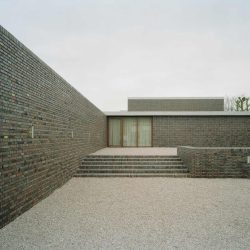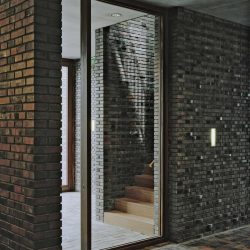
Rapp + Rapp . photos: © Kim Zwarts
In 2001 Rapp+Rapp was commissioned by the municipality of Houthulst to design a community centre for various cultural purposes. A characteristic feature of the village is the convergence of two main roads. At their intersection, a church with a cemetery and a presbytery are located at one corner, a pub at the second corner and a bank at the third. The fourth quadrant of the junction was to remain undeveloped because of the morphological significance of the surrounding landscape to the village. An L-shaped plot next to the church and behind the presbytery was designated as the plot for the community centre.
The nursery located in the presbytery was to be extended into the mini-cultural centre. Furthermore, the programme provided a theatre hall for both larger and smaller events, a foyer and a library. The foyer should also be suitable for performances. Some functions had to be replaceable over time. For some of them, this already happened during the design process. Library and nursery disappeared from the programme to make way for a music school.
The design of the building largely stems from the demand for flexibility, characteristics of the location and the desire to make it accessible from several directions. Massive facades guide visitors to the entrance and screen off the adjacent cemetery. The building’s entrance is located in the axilla of the building, at the point where the two lots meet. There, one enters the centrally located foyer. The theatre room has a stage tower and a central stage that is open on two sides. This allows the theatre to be used in different set-ups. According to need, the spaces can be adapted with flexible elements. The closed nature of the continuous walls alternates with the complete transparency of the interwoven spaces, which are in contact with the outside world through floor-to-ceiling windows.
The building is largely constructed in metric brick. All measurements of brick surfaces are derived from this metric system. This results in a clear structure that is reinforced by the way the brick and other materials fit together, for example, the oiled afromosia wooden window frames and the thin concrete roof slab that spans the theatre. The window frames are placed exactly in the centre of the wall thickness, making the recesses on the inside and outside the same size. They connect cold to the brick. The brickwork inside continues in the exterior.
By articulating the community centre in different volumes and, seen from the intersection, placed behind the church and next to the presbytery, it naturally joins into the space. The simple geometrical design with the interwoven spaces refers to classical modernism, the materialisation reflects the desire to place it in its surroundings in a natural way. The metric system, which has been implemented as far as possible, creates tranquillity and at the same time makes the building robust.
_


























